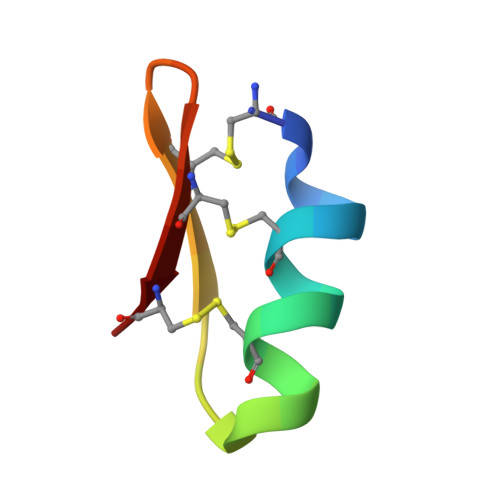Rational engineering of a miniprotein that reproduces the core of the CD4 site interacting with HIV-1 envelope glycoprotein.
Vita, C., Drakopoulou, E., Vizzavona, J., Rochette, S., Martin, L., Menez, A., Roumestand, C., Yang, Y.S., Ylisastigui, L., Benjouad, A., Gluckman, J.C.(1999) Proc Natl Acad Sci U S A 96: 13091-13096
- PubMed: 10557278
- DOI: https://doi.org/10.1073/pnas.96.23.13091
- Primary Citation of Related Structures:
1D5Q - PubMed Abstract:
Protein-protein interacting surfaces are usually large and intricate, making the rational design of small mimetics of these interfaces a daunting problem. On the basis of a structural similarity between the CDR2-like loop of CD4 and the beta-hairpin region of a short scorpion toxin, scyllatoxin, we transferred the side chains of nine residues of CD4, central in the binding to HIV-1 envelope glycoprotein (gp120), to a structurally homologous region of the scorpion toxin scaffold. In competition experiments, the resulting 27-amino acid miniprotein inhibited binding of CD4 to gp120 with a 40 microM IC(50). Structural analysis by NMR showed that both the backbone of the chimeric beta-hairpin and the introduced side chains adopted conformations similar to those of the parent CD4. Systematic single mutations suggested that most CD4 residues from the CDR2-like loop were reproduced in the miniprotein, including the critical Phe-43. The structural and functional analysis performed suggested five additional mutations that, once incorporated in the miniprotein, increased its affinity for gp120 by 100-fold to an IC(50) of 0.1-1.0 microM, depending on viral strains. The resulting mini-CD4 inhibited infection of CD4(+) cells by different virus isolates. Thus, core regions of large protein-protein interfaces can be reproduced in miniprotein scaffolds, offering possibilities for the development of inhibitors of protein-protein interactions that may represent useful tools in biology and in drug discovery.
Organizational Affiliation:
Département d'Ingénierie et d'Etudes des Protéines, Commissariat à l'Energie Atomique, Saclay, 91190 Gif-sur-Yvette, France. claudio.vita@cea.fr













